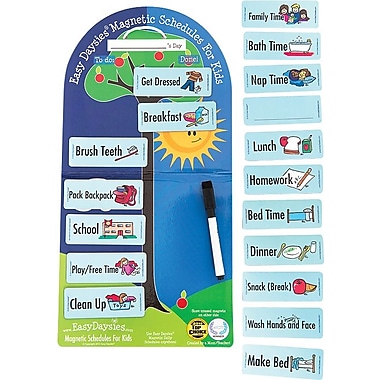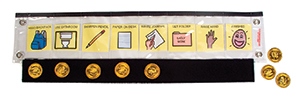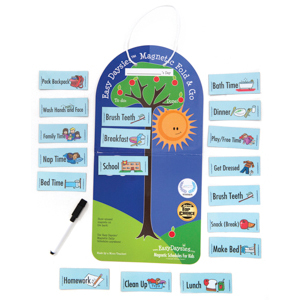 Help your child structure their daily routines to get off on the right start for school with the EasyDaysies Magnetic Schedule. Teach independence, responsibility, self-discipline, and sight-word recognition with this handy magnetic chart.
Help your child structure their daily routines to get off on the right start for school with the EasyDaysies Magnetic Schedule. Teach independence, responsibility, self-discipline, and sight-word recognition with this handy magnetic chart.
And you can save 15%* on your order of the EasyDaysies Magnetic Schedule, along with its three add-on kits: Chores & Special Times, Family & Extracurricular Activities, and Get Dressed & Bathroom Routines, when you enter promo code EASYDAYS at check-out online.
The EasyDaysies Magnetic Schedule comes with 18 magnets covering everyday activities such as “get dressed,” “do homework,” and “bath time.” You can also use the “To Do” and “Done” columns as a reward system.
The add-on kits offer an easy way to schedule daily chores, routines, and events, and helps to keep track of a child’s earned special times.

Chores & Special Times Add-On Kit comes with 21 amazing and durable illustrated magnets: Book/Quiet Time, Clean Bathroom, Clean Bedroom, Computer Time, Dishes, Feed Pet, Field Trip, Garbage/Recycling, Help Set Table, Put Clothes Away, Sweep/Vacuum, TV Time, Walk Dog, 2 blank magnets, and 6 blank clock magnets.

Family & Extracurricular Activites Add-On Kit comes with 18 durable illustrated magnets: Dance, Dentist, Doctor, Gymnastics, Martial Arts, Movie Night, Music, Party, Play Date, Play Outside, Shopping, Skating/Hockey, Soccer, Sports, Swimming, and 3 blank magnets.

Get Dressed & Bathroom Routines Add-On Kit comes with 18 helpful, prompting magnetic components, such as: Coat, Comb Hair, Dress/Skirt, Dry Hands, Flush, Lights Off, Pants, Pull Down Pants, Pull Up Pants, Sit on Toilet, Shirt, Shoes, Sock/Stockings, Underwear, Wash Hands, Wipe, and 2 blank magnets.
Don’t forget to redeem your savings this week on the EasyDaysies Magnetic Schedule and the supplemental packs for chores, family and extracurricular activities, and getting dressed and bathroom routines by entering our promo code EASYDAYS at check-out!
*Offer is valid until 11:59pm EDT on September 2nd, 2014. Not compatible with any other offers. Be sure there are no spaces or dashes in your code at check out!










 When faced with feeding issues, many parents or caregivers may not consider seeking out help from a BCBA or behavior analyst. There is a tendency to associate ABA with sitting at a table and completing discrete trials, but this is only one tool in a behavior analyst’s extensive toolkit. Whether you are providing intervention for feeding issues or seeking more information, it is essential to look to scientific research for help.
When faced with feeding issues, many parents or caregivers may not consider seeking out help from a BCBA or behavior analyst. There is a tendency to associate ABA with sitting at a table and completing discrete trials, but this is only one tool in a behavior analyst’s extensive toolkit. Whether you are providing intervention for feeding issues or seeking more information, it is essential to look to scientific research for help. Recently I took a thirteen-year-old boy with autism grocery shopping for the first time. We had practiced all of the steps for paying: looking at the total on the register, taking out the necessary bills or coins, waiting for change, making sure we had correct change, returning the money to the wallet, etc. While I thought he was ready to do this in a natural environment, I did not expect what actually happened.
Recently I took a thirteen-year-old boy with autism grocery shopping for the first time. We had practiced all of the steps for paying: looking at the total on the register, taking out the necessary bills or coins, waiting for change, making sure we had correct change, returning the money to the wallet, etc. While I thought he was ready to do this in a natural environment, I did not expect what actually happened. Keep your wallet in your hand, do not lay it on the counter.
Keep your wallet in your hand, do not lay it on the counter. As the school year comes to a close, it can be quite challenging to figure out how to fill all those summer hours for any child. But if your child has autism, the challenge to provide structure can prove especially difficult. Below are a few tips to assist you in that endeavor.
As the school year comes to a close, it can be quite challenging to figure out how to fill all those summer hours for any child. But if your child has autism, the challenge to provide structure can prove especially difficult. Below are a few tips to assist you in that endeavor.



 Summer is winding down and for most it’s time to get back to a routine. For many of our students and children that means getting a handle on a busy new schedule of self-care, school, therapy sessions, extra-curricular activities, play dates and special occasions. A visual schedule or an activity schedule can help pull all of the parts of a hectic day together for a child and increase independence, build organizational skills as well as improve comprehension skills. A visual schedule provides clear expectations, utilizes a child’s visual learning strengths, can reduce anxiety or difficulty with transitions, and can increase flexibility.
Summer is winding down and for most it’s time to get back to a routine. For many of our students and children that means getting a handle on a busy new schedule of self-care, school, therapy sessions, extra-curricular activities, play dates and special occasions. A visual schedule or an activity schedule can help pull all of the parts of a hectic day together for a child and increase independence, build organizational skills as well as improve comprehension skills. A visual schedule provides clear expectations, utilizes a child’s visual learning strengths, can reduce anxiety or difficulty with transitions, and can increase flexibility.

